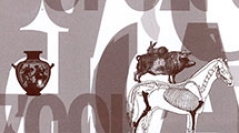

 Anthropozoologica
43 (2) - Pages 47-68
Anthropozoologica
43 (2) - Pages 47-68The Bible, in its Latin version, contributed to call attention to the Christian Occident to the existence of the camelopardalis (camel-panther or camel-leopard), a term referring to the giraffe in Greek and Latin in the Antiquity, and which had been used to translate a misidentified Hebrew zoonym, the zemer. While the giraffe remained unknown in Europe for a long time, only a brief notice by Pliny transmitted to the Middle Ages some information on the camelopardalis, in a lacunar description, omitting for example the height of the animal and the characteristic size of its neck, preventing from recognizing there a "true" giraffe, in particular when some specimens were brought from Egypt to be offered to the king Alfonso X of Spain and to the emperor Frederic II in the XIIIth century. While at that time the modern name for giraffe is formed on the Arab zarâfa, no literary or zoological text, no translation, no exegesis manage to connect this new animal, with the new vernacular name, to the ancient camelopardalis. The giraffe and the "camel-leopard" seem to have became then perfectly distinct animals. The translations in vernacular languages of the Bible from the Latin fail to correctly interpret this obscure animal, dubious, which seems to have only a philological reality. When giraffes make their return at the end of XVth century in Italy, several humanists then recognize in the giraffa the kamelopardalis recently translated and published from Greek texts. The erudition then makes it possible to reconcile book learning with observation of a "true" animal. The "real" giraffe then makes its return in the biblical exegesis of the XVIth and XVIIth centuries, the question of the translation of the Hebrew zemer also stimulating the scientific investigations on the giraffe of Conrad Gesner, Ulysses Aldrovandi and Samuel Bochart, transforming an exceptional exotic animal into a philological animal par excellence.
Giraffe, Bible, Deuteronomy, animal naming, Bible animals, camelopardalis, biblical exegesis, Middle Ages, philology, names of the giraffe.